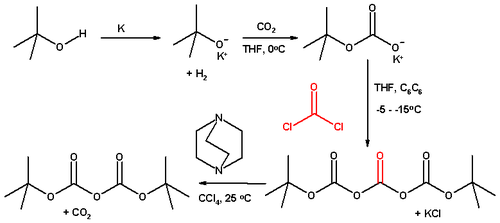Di-tert-butyl dicarbonate
 | |
 | |
| Names | |
|---|---|
| IUPAC name
Di-t-butyl dicarbonate | |
| Other names
di-tert-butyl pyrocarbonate Boc anhydride Boc2O | |
| Identifiers | |
| 24424-99-5 | |
| ChEBI | CHEBI:48500 |
| ChemSpider | 81704 |
| |
| Jmol-3D images | Image |
| PubChem | 90495 |
| |
| Properties | |
| C10H18O5 | |
| Molar mass | 218.25 g·mol−1 |
| Appearance | colourless solid |
| Density | 0.95 g·cm−3 |
| Melting point | 22 to 24 °C (72 to 75 °F; 295 to 297 K) |
| Boiling point | 56 to 57 °C (133 to 135 °F; 329 to 330 K) (0.5 mmHg) |
| insol | |
| Solubility in other solvents | most organic solvents |
| Structure | |
| Dipole moment | 0 D |
| Hazards | |
| Main hazards | toxic on inhalation T+ |
| Related compounds | |
| Related compounds |
ethyl chloroformate phosgene diethylpyrocarbonate dimethyl dicarbonate |
| Except where noted otherwise, data is given for materials in their standard state (at 25 °C (77 °F), 100 kPa) | |
| | |
| Infobox references | |
Di-tert-butyl dicarbonate is a reagent widely used in organic synthesis.[1] This carbonate ester reacts with amines to give N-tert-butoxycarbonyl or so-called Boc derivatives. These derivatives do not behave as amines, which allows certain subsequent transformations to occur that would have otherwise affected the amine functional group. The Boc can later be removed from the amine using acids. Thus, Boc serves as a protective group, for instance in solid phase peptide synthesis. It is unreactive to most bases and nucleophiles, allowing for an orthogonal Fluorenylmethyloxycarbonyl chloride (FMOC-Cl) protection.
Preparation
Di-tert-butyl dicarbonate is inexpensive, so it is usually purchased. Classically, this compound is prepared from tert-butanol, carbon dioxide, phosgene, using DABCO as a base:[2]
This route is currently employed commercially by manufacturers in China and India. European and Japanese companies use the reaction of sodium tert-butylate with carbon dioxide, catalysed by p-toluenesulfonic acid or methanesulfonic acid. This process involves a distillation of the crude material yielding a very pure grade.
Boc anhydride is also available as a 70% solution in toluene or THF. As boc anhydride may melt at ambient temperatures, its storage and handling is sometimes simplified by using a solution.
Protection and deprotection of amines
The Boc group can be added to the amine under aqueous conditions using di-tert-butyl dicarbonate in the presence of a base such as sodium bicarbonate. Protection of the amine can also be accomplished in acetonitrile solution using 4-dimethylaminopyridine (DMAP) as the base.
Removal of the Boc in amino acids can be accomplished with strong acids such as trifluoroacetic acid neat or in dichloromethane, or with HCl in methanol.[3][4][5] A complication may be the tendency of the t-butyl cation intermediate to alkylate other nucleophiles; scavengers such as anisole or thioanisole may be used.[6][7] Selective cleavage of the N-Boc group in the presence of other protecting groups is possible when using AlCl3.
The use of triethylsilane as a carbocation scavenger in the presence of trifluoroacetic acid in dichloromethane has been shown to lead to increased yields, decreased reaction times, simple work-up and improved selectivity for the deprotection of t-butyl ester and t-butoxycarbonyl sites in protected amino-acids and peptides in the presence of other acid-sensitive protecting groups such as the benzyloxycarbonyl, 9-fluorenylmethoxycarbonyl, O- and S-benzyl and t-butylthio groups.[8]
Other uses
The synthesis of 6-acetyl-1,2,3,4-tetrahydropyridine, an important bread aroma compound from 2-piperidone was accomplished using t-boc anhydride.[9] (See Maillard reaction). The first step in this reaction sequence is the formation of the carbamate from the reaction of the secondary amine with boc anhydride in acetonitrile with DMAP as a catalyst.
References
- ↑ M. Wakselman, "Di-t-butyl Dicarbonate" in Encyclopedia of Reagents for Organic Synthesis (Ed: L. Paquette) 2004, J. Wiley & Sons, New York. doi:10.1002/047084289.
- ↑ B. M. Pope, Y. Yamamoto, and D. S. Tarbell (1988). "Dicarbonic acid, bis(1,1-dimethylethyl) ester". Org. Synth.; Coll. Vol. 6, p. 418
- ↑ R. M. Williams, P. J. Sinclair, D. E. DeMong, D. Chen, and D. Zhai (2003). "4-Morpholinecarboxylic acid, 6-oxo-2,3-diphenyl-, 1,1-dimethylethyl ester, (2S,3R)-". Org. Synth. 80: 18.
- ↑ E. A. Englund, H. N. Gopi, D. H. Appella (2004). "An Efficient Synthesis of a Probe for Protein Function: 2,3-Diaminopropionic Acid with Orthogonal Protecting Groups". Org. Lett. 6 (2): 213–215. doi:10.1021/ol0361599. PMID 14723531.
- ↑ D. M. Shendage, R. Fröhlich, G. Haufe (2004). "Highly Efficient Stereoconservative Amidation and Deamidation of α-Amino Acids". Org. Lett. 6 (21): 3675–3678. doi:10.1021/ol048771l. PMID 15469321.
- ↑ Lundt, Behrend F.; Johansen, Nils L.; Vølund, Aage; Markussen, Jan (1978). "Removal of t-Butyl and t-Butoxycarbonyl Protecting Groups with Trifluoroacetic acid". International Journal of Peptide and Protein Research 12 (5): 258–268. doi:10.1111/j.1399-3011.1978.tb02896.x. PMID 744685.
- ↑ Andrew B. Hughes. "1. Protection Reactions". In Vommina V. Sureshbabu, Narasimhamurthy Narendra. Amino Acids, Peptides and Proteins in Organic Chemistry: Protection Reactions, Medicinal Chemistry, Combinatorial Synthesis 4. doi:10.1002/9783527631827.ch1.
- ↑ Anita Mehta, R. Jaouhari, T. J. Benson, K. T. Douglas (1992). Tetrahedron Letters 33 (37): 5441–5444. doi:10.1016/s0040-4039(00)79116-7. Missing or empty
|title=(help) - ↑ T. J. Harrison and G. R. Dake (2005). "An Expeditious, High-Yielding Construction of the Food Aroma Compounds 6-Acetyl-1,2,3,4-tetrahydropyridine and 2-Acetyl-1-pyrroline". J. Org. Chem. 70 (26): 10872–10874. doi:10.1021/jo051940a. PMID 16356012.
External links
- Protection or deprotection conditions - Synthetic protocols from organic-reaction.com
- Basel, Yochai; Hassner, Alfred (2001). "Imidazole and Trifluoroethanol as Efficient and Mild Reagents for Destruction of Excess Di-tert-butyl Dicarbonate [(BOC)2O]". Synthesis 2001 (4): 0550. doi:10.1055/s-2001-12350.

